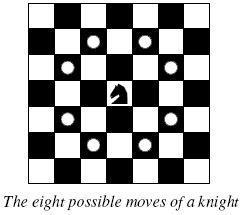A Knight's Journey
A Knight's Journey
| Time Limit: 1000MS | Memory Limit: 65536K | |
| Total Submissions: 26808 | Accepted: 9140 |
Description
 Background
Background
The knight is getting bored of seeing the same black and white squares again and again and has decided to make a journey
around the world. Whenever a knight moves, it is two squares in one direction and one square perpendicular to this. The world of a knight is the chessboard he is living on. Our knight lives on a chessboard that has a smaller area than a regular 8 * 8 board, but it is still rectangular. Can you help this adventurous knight to make travel plans?
Problem
Find a path such that the knight visits every square once. The knight can start and end on any square of the board.
Input
The input begins with a positive integer n in the first line. The following lines contain n test cases. Each test case consists of a single line with two positive integers p and q, such that 1 <= p * q <= 26. This represents a p * q chessboard, where p describes how many different square numbers 1, . . . , p exist, q describes how many different square letters exist. These are the first q letters of the Latin alphabet: A, . . .
Output
The output for every scenario begins with a line containing "Scenario #i:", where i is the number of the scenario starting at 1. Then print a single line containing the lexicographically first path that visits all squares of the chessboard with knight moves followed by an empty line. The path should be given on a single line by concatenating the names of the visited squares. Each square name consists of a capital letter followed by a number.
If no such path exist, you should output impossible on a single line.
If no such path exist, you should output impossible on a single line.
Sample Input
3 1 1 2 3 4 3
Sample Output
Scenario #1: A1 Scenario #2: impossible Scenario #3: A1B3C1A2B4C2A3B1C3A4B2C4
题目大意:就是让骑士走遍棋盘, 按日字形走, 找出可遍历棋盘的路径, 并按照字典序输出
思路:主要都是按字典序输出, 这与方向的优先级别有关, 还有就是每组数据结束后有一空行, 不要被坑了。。。
#include <stdio.h>
#include <string.h>
#include <stdlib.h>
#include <iostream>
using namespace std;
#define MAX 10
bool vis[MAX][MAX], flag; //标记已访问,是否查找到结果
int m, n, cnt = 1, dir[8][2] = {{-2, -1}, {-2, 1}, {-1, -2}, {-1, 2}, {1, -2}, {1, 2}, {2, -1}, {2, 1}}; //方向, 注意如果按字典序输出的话必须x从小到大,y从小到大
typedef struct Elem //用来记录路径的结构体
{
int x;
int y;
}elem;
elem ans[100]; //用来记录路径的结构体
void dfs(int count, elem pos) //用深搜搜出路径
{
if(flag)
{
return;
}
elem temp;
if(count == m * n) //找到路径, 打印结果
{
printf("Scenario #%d:\n", cnt++);
for(int i = 0; i < m*n; i++)
{
printf("%c%d", ans[i].x+65, ans[i].y+1);
}
printf("\n\n"); //注意此处超坑要加空行
flag = 1;
return;
}
for(int j = 0; j < 8; j++)
{
temp.x = pos.x + dir[j][0];
temp.y = pos.y + dir[j][1];
if(temp.x >= 0 && temp.x < n && temp.y >= 0 && temp.y < m && !vis[temp.x][temp.y]) //不多说老套深搜
{
ans[count] = temp;
vis[temp.x][temp.y] = 1;
dfs(count+1, temp);
vis[temp.x][temp.y] = 0;
}
}
}
int main()
{
int k;
elem sp = {0, 0}; //起点
scanf("%d", &k);
while(k--)
{
scanf("%d%d", &m, &n);
memset(vis, 0, sizeof(vis));
flag = 0;
ans[0] = sp;
vis[0][0] = 1;
dfs(1, sp);
if(!flag) //未找到路径
{
printf("Scenario #%d:\nimpossible\n\n", cnt++);
}
}
return 0;
}